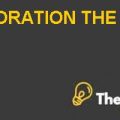
Differentiate between Opportunity Cost and Relevant Cost with the help of two examples.
Opportunity Cost
The opportunity cost is actually the cost related to an adopted alternative. If a person chose a certain alternative over another as a replacement, then the cost of selecting that alternative is an opportunity cost. It is the benefit that is lost by a person through choosing one substitute over another one (Sabine, 2014).
For example a student gives up going to watch a show and decided to study for examination in order to obtain a good score. In this situation the opportunity cost is the cost of the ticket and the satisfaction of seeing it.
A person has $15,000/- value of stocks and he can sell now for around $20,000/-. He wanted to wait for around two months because the stock was projected to show some increase. He now decides to sell it. In this situation the opportunity cost would be calculated at 2 months and would be the change in between the $20,000/- and the value he would have acquired if he actually sold the stock then.
Relevant Cost
It is a managerial accounting terminology that is used to define the costs that are particularly related to management's decisions. This actually excludes pointless data that could affect the entire decision-making process.
For example, if the person is deciding whether to purchase a Honda City or a Toyota Yaris, and if his auto insurance will be the similar no matter which automobile he actually buys, his consideration towards the insurance costs will not disturb the decision, though it will marginally complicate the decision.
Case incidence on marginal analysis.
Marginal analysis is known as the examination of the extra benefits of an activity matched with the surplus costs of that particular activity. Different companies across the world uses the marginal analysis for decision making which helps them in maximizing their profits. Marginal analysis is a significant decision making technique in the corporate world, allows the managers to calculate the extra benefits of one production activity in relation to its costs (McKenzie, 1954). This examination helps the company’s management to understand whether a certain action is cost-effective and thus make a choice based on that calculated information. As mentioned in the case the Americans had been using the old conventional approach of old furnace and even added a massive amount of 50 million tons of old furnace. As the time passes the countries like Japan and Korea recognize the extra benefits of get the plants updated with latest technology. Due to the exceptional marginal analysis of the companies in Japan and Korea, it actually helped them in grabbing the first mover advantage by adopting the new and updated technology. The cost advantage was one of the biggest reasons to go for such adaptation of new technology and building the new plants.
Explain how different theories presented in this case study are supported and how they can be tested in general terms. Relate your understanding of the case study with least one example of the current business scenario in the GCC countries.
Countries and even companies on an individual basis across the globe are now busy in adopting the new updated technology to face the extreme competition. Let’s take the example of Gulf countries who have not been able to contribute much in the global manufacturing economy, but in some cases, they have been doing an exceptional job. The Gulf Aluminum Council (GAC) stated that the existing GCC operational smelters Alba, emal, Dubai, Sohar and Qatalum have mutually produced around 3,739,290 tons of aluminum in the year 2012 in comparison with the 3,488,357 tons of production in 2011.
The GCC countries have been a significant aluminum producers as it was projected to account for around 13% of the entire world’s total production by the end of previous year 2013. This achievement is mainly driven by enormous investments in the GCC aluminum industry (Samuelson, 2001). This includes the building of new plants and the extension of the pipeline system that has additionally reinforced the region’s position in the global marketplace. Gulf Aluminum Council (GAC) Secretary-general Mr. Mahmood Daylami in an interview said that Aluminum industry is now becoming one of the significant economic drivers for the Gulf and it is contributing to thousands of job creation, creation of medium and even small size industries and additionally contributing to the development of community in an optimistic manner. Before forty years GCC countries, specifically UAE was facing some growth and development issues, but they have shown some exceptional growth in the last 2 decades...............................
This is just a sample partial case solution. Please place the order on the website to order your own originally done case solution.










